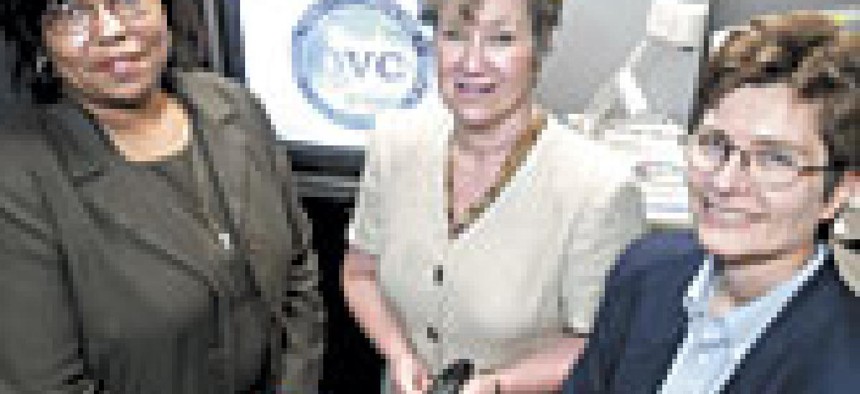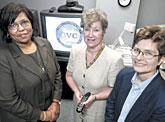The State Department's videoconferencing studio can set up a two-hour meeting across continents with a $500 phone call instead of a $10,000 bill for travel plus jet lag.Because the cost and complexity of videoconferencing have fallen dramatically, State has outfitted more than 160 of its outposts around the world with the equipment.The Washington studio has facilitated about 500 international meetings, said Sandra G. Bruckner, videoconferencing coordinator for State's Office of International Information Programs.Bruckner and two other coordinators, Sheila Savoy and Betty J. Hayes, work in a Washington building that formerly housed the U.S. Information Agency, which was absorbed into State in 1999.State bought its first videoconferencing equipment in the early 1990s from VTel Corp. of Austin, Texas. The setups went to 12 international locations to augment the American Participant Program, which had been ferrying American experts to face-to-face lectures and seminars since the 1960s.'As our budget started to shrink, we thought about how to provide the same service with less money,' Bruckner said. 'Videoconferencing seemed to be the viable alternative.'But it did not start off cheaply. Each VTel system'a computer with a 33-MHz 386 processor and video card, plus camera, large monitor and cabinetry'cost about $60,000. State officials started to question the equipment's readiness for year 2000, Bruckner said.As the studio hosted more conferences and State increased the number of foreign outposts equipped to handle them, equipment prices kept going down, but a midrange system still cost $28,000, Bruckner said.When Polycom Inc. of Milpitas, Calif., introduced set-top videoconferencing equipment about four years ago, it was 'too good a deal to pass up,' Bruckner said. The current cost runs about $10,000 per unit.The Polycom ViewStation MP is at about 160 locations, including all consulates in some countries such as Germany, India and South Africa. In other countries, only the U.S. embassy has one.Counting the integrated camera, the ViewStation MP weighs 7 pounds and is easy to move around, Bruckner said. At some posts that don't have their own Integrated Services Digital Network lines, personnel have taken the units to nearby hotels.'Abroad, the hardest thing is to find an ISDN line,' Bruckner said.State Department and foreign officials who videoconference the most are stationed in remote parts of Africa, where a plane might land and take off once a week, or East Asia, which takes up to 24 hours to reach from Washington, Bruckner said.Some officials argue that videoconferencing cannot replace face-to-face meetings, Bruckner said. But why take a two-day trip to attend a two-hour conference? she said she asks them.For prominent people who have been invited to speak at a foreign post, time is often the critical factor in getting an acceptance, Bruckner said.During a conference, one of the coordinators sits in the Washington studio to run the Polycom device by its remote control, Bruckner said. At the international end of the line, someone else uses a local remote control to zoom in and out or pan the camera to the next speaker.'Sometimes they make us seasick with their panning,' Bruckner said. 'They don't recognize the effect it has on this end.'The remote control is fairly intuitive even for people who know little English, Bruckner said, and 'we're real good at charades, too.'The coordinators keep an eye out for potential problems with the ISDN connection. When connections aren't always reliable, such as to Mumbai, India, they keep a phone line open to the other site, just in case.The Washington studio has a sound-insulated translator's booth for use when language differences require it. The sound from the Polycom unit goes straight to the booth and into the translator's headphones. The translator's voice goes out from the microphone into the room's public-address system, and a ceiling-mounted microphone picks up the Washington end of the discussion for the translator to hear.When numerous people want to listen to a lecture or seminar without two-way participation, the studio has a Polycom StreamStation server that encodes and streams the camera output across the Internet, Bruckner said. Up to 40 viewers can access a conference simultaneously, although they can't join in the discussion.The Washington studio uses several 32- and 27-inch monitors, including one left over from the original VTel setup.ISDN transmission gives the video a not-quite-broadcast-quality look, Bruckner said. The studio uses commercial basic-rate-interface service from Verizon Communications Inc. that costs about $35 per month per line, plus a charge of $4 per minute for international access at 128 Kbps. If speakers in the Washington studio want to display printed charts and graphs, they use a Canon RE-350 Video Visualizer document camera from Canon USA Inc. of Lake Success, N.Y. Speakers can also plug a notebook computer into the ViewStation MP to run Microsoft PowerPoint slide shows.All federal agencies are eligible to reserve the studio at the $4-per-minute charge for the ISDN line, Bruckner said. At times the three coordinators work well past standard office hours because of the time zones separating participants. Usually 10 p.m. Eastern time is the suggested cutoff, Hayes said. But sometimes foreign panelists just keep on going, Savoy said, because on the other side of the world the workday is just beginning.Although Secretary of State Colin Powell hasn't yet traveled across town to Bruck-ner's studio, he was scheduled to participate in the NetDiplomacy 2001 conference this month. Bruckner and her colleagues took a Polycom unit to State headquarters for three hours of video streaming and 10 hours of audio streaming.They are evaluating desktop video-editing software so that they can place short clips of future departmental videoconferences on the Web.For example, AIDS and biotechnology are hot issues, and many people around the world might be interested in the studio guests' comments, Bruckner said.
At the State Department's videoconferencing studio, Sheila Savoy, left, Betty J. Hayes and Sandra G. Bruckner hold the remote control.







